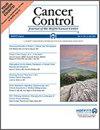DDR1 是一种新型生物标记物,也是肝肝细胞癌联合治疗的潜在治疗靶点
IF 2.5
4区 医学
Q3 ONCOLOGY
引用次数: 0
摘要
目的 本研究旨在探讨盘状蛋白结构域受体酪氨酸激酶1(DDR1)在肝脏肝细胞癌(LIHC)中的作用,并评估其对患者联合治疗反应的预后价值。方法 在本回顾性研究中,我们采用标准免疫组化(IHC)方法检测了DDR1在各种癌症中的蛋白表达,并评估了其在LIHC个性化治疗中的临床意义。研究使用了多个在线数据库,包括癌症基因组图谱(TCGA)、TIMER、GEO、ROC Plotter和癌症药物敏感性基因组学(GDSC)。此外,与 HBs 阳性的 LIHC 组织相比,DDR1 在邻近正常组织中的表达水平更高。单细胞分辨率分析显示,DDR1主要在上皮细胞中表达,而不在基质细胞和免疫细胞中表达,与正常肝细胞相比,DDR1在HBs阳性的LIHC细胞中表达较低。在患者队列中观察到 DDR1 上调与索拉非尼耐药相关。此外,DDR1 的表达与 LIHC 中炎症反应相关基因、ECM 相关基因和胶原形成相关基因的表达呈正相关,但与 CD8+ T 细胞、NK 细胞和树突状细胞的浸润呈负相关。结论我们的研究结果表明,DDR1的表达可能是由参与肝损伤和修复的胶原形成相关细胞事件诱导的,DDR1的过表达可能会导致LIHC靶向治疗和免疫治疗的耐药,这突出表明DDR1是一种潜在的预后生物标志物和治疗靶点。本文章由计算机程序翻译,如有差异,请以英文原文为准。
DDR1 is a Novel Biomarker and Potential Therapeutic Target for the Combination Treatment of Liver Hepatocellular Carcinoma
AimThis study aimed to investigate the role of discoidin domain receptor tyrosine kinase 1 (DDR1) in liver hepatocellular carcinoma (LIHC) and to evaluate its prognostic value on patient response to combination therapy.MethodsIn the current retrospective study, we examined the protein expression of DDR1 in various cancers by standard immunohistochemical (IHC) methods and evaluated its clinical significance in LIHC personalized treatment. Multiple online databases, including The Cancer Genome Atlas (TCGA), TIMER, GEO, ROC Plotter, and Genomics of Drug Sensitivity in Cancer (GDSC), were used.ResultsDDR1 protein expression was higher in LIHC than in other nine examined cancer types. Additionally, DDR1 exhibited higher expression levels in adjacent normal tissues compared to HBs-positive LIHC tissues. Analysis at single-cell resolution revealed that DDR1 was expressed primarily in epithelial cells but not in stromal and immune cells, and DDR1 expression was lower in HBs-positive LIHC cells in comparison with normal hepatocytes. Correlation of DDR1 upregulation and sorafenib resistance was observed in the patient cohort. Moreover, DDR1 expression positively correlated with the expression of inflammatory response-related genes, ECM-related genes, and collagen formation-related genes, but negatively correlated with the infiltration of CD8+ T cells, NK cells, and dendritic cells in LIHC.ConclusionsOur findings suggest that DDR1 expression might be induced by collagen production-related cellular events involved in liver injury and repair, and that DDR1 overexpression might contribute to the resistance to LIHC targeted therapy and immunotherapy, highlighting DDR1 as a potential prognostic biomarker and therapeutic target.
求助全文
通过发布文献求助,成功后即可免费获取论文全文。
去求助
来源期刊

Cancer Control
ONCOLOGY-
CiteScore
3.80
自引率
0.00%
发文量
148
审稿时长
>12 weeks
期刊介绍:
Cancer Control is a JCR-ranked, peer-reviewed open access journal whose mission is to advance the prevention, detection, diagnosis, treatment, and palliative care of cancer by enabling researchers, doctors, policymakers, and other healthcare professionals to freely share research along the cancer control continuum. Our vision is a world where gold-standard cancer care is the norm, not the exception.
 求助内容:
求助内容: 应助结果提醒方式:
应助结果提醒方式:


